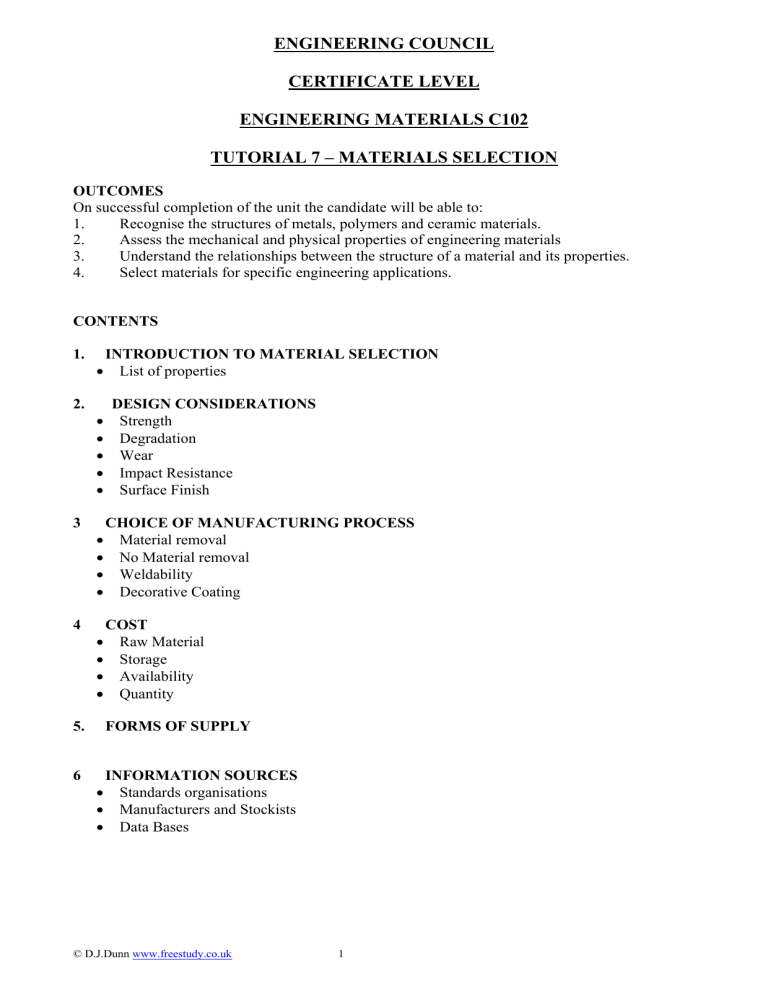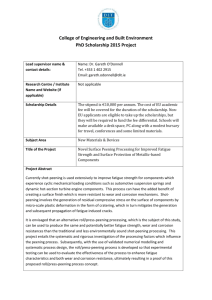
ENGINEERING COUNCIL CERTIFICATE LEVEL ENGINEERING MATERIALS C102 TUTORIAL 7 – MATERIALS SELECTION OUTCOMES On successful completion of the unit the candidate will be able to: 1. Recognise the structures of metals, polymers and ceramic materials. 2. Assess the mechanical and physical properties of engineering materials 3. Understand the relationships between the structure of a material and its properties. 4. Select materials for specific engineering applications. CONTENTS 1. 2. 3 4 INTRODUCTION TO MATERIAL SELECTION • List of properties • • • • • CHOICE OF MANUFACTURING PROCESS • Material removal • No Material removal • Weldability • Decorative Coating • • • • 5. 6 DESIGN CONSIDERATIONS Strength Degradation Wear Impact Resistance Surface Finish COST Raw Material Storage Availability Quantity FORMS OF SUPPLY • • • INFORMATION SOURCES Standards organisations Manufacturers and Stockists Data Bases © D.J.Dunn www.freestudy.co.uk 1 1. INTRODUCTION TO MATERIAL SELECTION The choice of material to be used for a given component/structure/product depends on many things. The most important thing is to know and understand the properties of materials so that you can search for a suitable one. Here is a list of material properties that you might be required to enter in a search. It is not complete and the explanations of some of them are spread throughout the tutorials. MECHANICAL PROPERTIES Modulus Elastic (E) Shear(G) Bulk (K) Poisson’s ratio Ductility - % elongation and area reduction Strength Tensile Compressive strength Shear strength Hardness Brinell Rockwell Vickers Malleability Impact strength:Brittleness - Izod, Charpy Toughness - Izod, Charpy Notch sensitivity - Izod, Charpy Fatigue properties Creep properties Density Porosity Coefficient of friction. THERMAL PROPERTIES Melting point Solidus Latent heat of fusion Thermal conductivity Thermal expansion Temperature coefficient of resistance Brittle transition temperature Glass Temperature Maximum service temperature Melt flow Processing Temperature Vicat softening Temperature Deterioration at high temperatures Corrosion Resistance Resistance to oxidation Resistance to Suphidation Stability of properties when in service Resistance to abrasion and erosion Resistance to various chemical attacks SUITABILITY FOR METHOD OF MANUFACTURE. Machineability Weldability Arc Resistance Ability to be hot and cold rolled Ability to be drawn Ability to be forging Ability to be Extruded Ability to be Cast Mould Shrinkage Surface finish and appearance ELECTRICAL PROPERTIES Resistivity Permittivity Dielectric Constant Dielectric Strength MAGNETIC PROPERTIES Permeability OPTICAL Emissivity Reflection Coefficient Refractive Index OTHER Water Absorption Oxygen Index Solubility DURABILITY/DEGRADATION Values can be entered into various search engines connected to data bases to find materials with the property values required. In arriving at these values you will go through other processes and the following is about these processes. Something not mentioned in the syllabus that has become a major consideration is the recycling of the materials at the end of the life span and perhaps recyclability will one day be a property. © D.J.Dunn www.freestudy.co.uk 2 2 DESIGN CONSIDERATIONS The design engineer has a very large say in the choice of materials. Some of the things they should consider in the design process are given here. STRENGTH The component/structure/product must not fail under the action of expected stresses and forces during its intended life span. Strength can mean many things, tensile, compression, shear or torsional. The strength can be weakened due to service factors such as stress corrosion and fatigue so there are many things to consider. ELASTICITY The elasticity of a component depends on its modulus and explanations of Elastic, Shear and Bulk modulus along with the relationship with Poisson’s ratio will be found in other modules that you should be studying. DEGRADATION The material must not become degraded due to service or environmental factors. This will reduce its intended life span. There are many things that cause a material to degrade such as corrosion, wear, chemical attack and radiation. WEAR Wear is a form of degradation due to surfaces rubbing together. The designer needs to understand Tribology (friction and wear of rubbing surfaces). He must select materials with suitable compatibility and wear resistance. IMPACT RESISTANCE This can be a form of degradation but also affects the strength. It occurs when the surface becomes damaged due to being struck. This could lead to fatigue failure or to sudden cracking in brittle materials. It also affects the visual appearance and may be important in house hold goods such as work tops and cooker surfaces. SURFACE FINNISH The final treatment of manufactured parts is called the finishing process and materials must be suitable for the process. This is conducted in order to do the following. • • • Protect the part from corrosion and other chemical attacks. To produce enhanced physical surface properties. To produce an attractive appearance. Here is a list of finishing processes that might be used. • Galvanising • Sherardising • Calorising • Chromising • Chromating • Phosphating • • • • • • Metal Spraying Cladding Anodising Electroplating Plastic Coating Paint Coating Some of the processes enhance the physical properties of the surface material. For example shot blasting and some machining processes place the surface into compression and so prevent the propagation of cracks. Shot blasting also relieves surface stresses. Polishing removes fine surface cracks and improves the fatigue life of the component. Coating the surface may produce better lubrication (e.g. coating in a soft metal such as indium). Other coatings (such as chrome plating) produce a hard surface. Surface hardening will make the surface resist wear and scratches. © D.J.Dunn www.freestudy.co.uk 3 3 CHOICE OF MANUFACTURING PROCESS The cost of producing the component is always a big factor and the designer must consider how the component/structure/product is manufactured. To a large extent, the manufacturing process is governed by the material. The shape, size and quantities of the component are a major factor governing the manufacturing process. The mechanical properties of the finished component are affected by the manufacturing method. For example forging a crankshaft is better than turning one because it produces a grain flow that makes it stronger and more resistant to fatigue failure. Grinding and polishing also produces better fatigue strength. Here is a list of manufacturing processes. Its is not a complete list WITHOUT REMOVING MATERIAL Casting. Moulding. Forging. Drawing. Bending. Pressing. MATERIAL REMOVAL Turning (lathes) Milling. Drilling. Shaping. Broaching. Blanking. Electrical erosion. Chemical erosion. Grinding. The tolerance on the finished size also governs the method. Casting and moulding does not produce a high tolerance and generally material removal is the best way to produce an accurate size or fit. (e.g. grinding the outer and inner ring of a bearing race). If a mass produced component with a high tolerance is to be made, special machine tools such as broaches might be best. WELDABILITY Clearly any structured designed for welding must be suitable for that process and the weldability of the material is an important consideration. Arc resistance may also be a consideration. © D.J.Dunn www.freestudy.co.uk 4 4 COST The cost of the product depends on the design and manufacture (processing) as covered in the preceding work. In addition costs depend on the following. RAW MATERIAL When more than one material meets the required specifications, the cheapest material would be logically chosen and these depend largely on the price of the raw material. For example when copper is expensive, there is a tendency to make electrical conductors from aluminium even though the cable diameter has to be increased to meet the resistance criteria. Materials chosen for large scale manufacture may well be different to those chosen for small scale quantities. For small quantities, the material cost is not so important. STORAGE The material to be used and the end product may have to be stored and transported so the material must not degrade whilst in storage. Steel stock, for example should not be stored in the open where rain will accelerate rust. If a supplier can reliably supply stock quickly, then you need not bear the cost of storage. AVAILABILITY Again if more than one material meets the required specification, the final choice of material may depend on the availability and the one most readily available would be chosen. QUANTITY The price of materials may well depend on contractual arrangements with discount for quantities and regularity of orders. The choice of material, all other being equal, is not so important for small quantities. 5 FORMS OF SUPPLY The choice of material may depend on the form of supply. The manufacturing process governs this to a large extent. For example a cylindrical component might be made from stock tube or made from flat sheet. The latter is cheaper but extra costs are involved in forming it. Here are some of the many forms of material Plate Coil Bar The material may be supplied in a form close to required finished product so cost can be saved in the manufacture. Standard extrusions and standard sections may be cheaper to buy and modify than fabricating or machining the shape from cheaper forms such as barstock. Here are some examples of extrusions. Other forms of material might include, ingots, castings and mouldings, forgings and pressings, granules and powders, chemical liquids © D.J.Dunn www.freestudy.co.uk 5 Tube 6. INFORMATION SOURCES When searching for a material, the following information should be useful but in reality finding published data on material properties is quite difficult. BRITISH STANDARDS SPECIFICATIONS (BS) This specifies sizes and properties to which manufacturers should conform. For example BS4 gives the dimensions of standard rolled steel universal beams. These standards are available for purchase. http://www.bsonline.bsi-global.com/server/index.jsp INTERNATIONAL STANDARDS ORGANISATION (ISO) Most British Standards now conform to ISO and when viewing BS the equivalent ISO is given. A useful list of international standards and properties of materials may be found at http://www.westyorkssteel.com/Steel_Specifications/natstds.htm MANUFACTURERS AND STOCKISTS and DATA BASES Properties of materials are also supplied by manufacturers and stockist. Finding actual properties on the web is difficult. Often the best way into web sites are through directories and for mechanical engineering many links will be found at http://www.roymech.co.uk/Useful_Tables/ This web site lists the steel stock at Corus http://www.corusengineeringsteels.com/services/stocklist/ This website gives access to the properties of their range of copper, nickel and beryllium alloys. http://www.brushwellman.com/# This website gives access to aluminium alloy properties. http://aluminium.matter.org.uk/aluselect/default.asp This website gives properties of plastics and in addition you will find much information about polymers. http://www.bpf.co.uk/ Many organisations have produced material data bases which are available on CD rom or over the net. One of the most useful is www.matweb.com This link has a good search tool for polymers based on many material properties. http://www.matdat.qinetiq.com/search_advanced.asp The following link has limited material search including a useful one on compatibility. http://www.upchurch.com/TechInfo/chemComp.asp The following link gives a good data base for noble metals. http://www.platinummetalsreview.com/jmpgm/index.jsp Some useful general material properties can be found at this link. http://www.efunda.com/materials/materials_home/materials.cfm This web site has some useful information on Aluminium http://www.world-aluminium.org/production/processing/properties.html This web site had many downloads on properties of metals and other information on the areas covered in these tutorials. http://www.aalco.co.uk/index.html This web site contains materials properties and calculator tools for material failures http//:emat.eng.hmc.edu © D.J.Dunn www.freestudy.co.uk 6 SELF ASSESSMENT EXERCISE Go to the Website Matweb.com and search for the materials listed below. Print off a copy of what you find. For each find out the following. • • • • • The exact composition The exact condition The tensile strength The yield strength The elongation % Materials to be found are as follows. • • • • • Aluminium 1050-O Copper UNS C10200 Grey cast iron. Magnesium alloy A2 31B-0 Aluminium Alloy 1201 For each material, find an example of what it is used to make. © D.J.Dunn www.freestudy.co.uk 7




